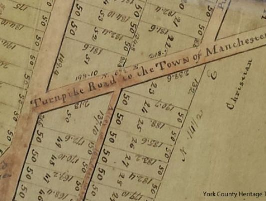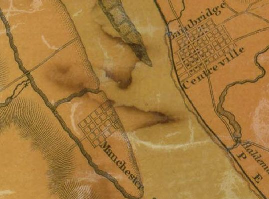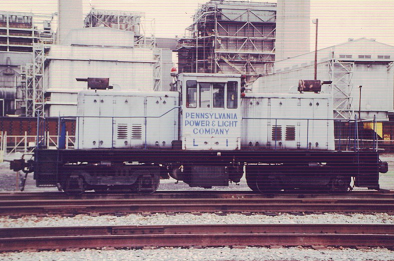

Eib's Landing (Brunner Island) Area History
North Eastern York County History In Preservation NeyChip
"Among the early settlers west of the Susquehanna was Peter Eib, who took up the fertile land forming a delta between the mouths of the Conewago Creek. As the lumber interests up the river were developed, a section of his farm, now owned by George W. Ilgenfritz, of York, became one of the most important landing places for this valuable product along the stream. There was a demand for pine timber, and from this landing place York, and a broad expanse of country, were largely supplied for more than half a century. But the glory of Eib’s Landing declined when the steam saw-mills were built at York Haven and at Goldsboro, and when the Northern Central Railway was completed. Old citizens of the neighborhood recalled the time when as many as seventy-five teams were in waiting to load lumber in one day. For one mile along the bank were continuous piles of boards and building timber. The price, on account of the abundance, was very low in comparison with present prices. Excellent shaved shingles could be purchased at $6 per 1,000, and a fine quality of boards at $8 and $10 per 1,000 feet.
During the spring and early summer, business was most flourishing. For many years there were three hotels, to accommodate teamsters and lumbermen – “Yankees,” as they were termed, who brought the rafts of lumber down the Susquehanna. At times ardent spirits flowed profusely, and occasions of boisterous hilarity were very frequent. Much sawed timber was conveyed in teams by merchants who owned lumber yards in York, Hanover, Abbottstown, East Berlin, and as far away as Frederick, Md. There is nothing now left to mark this, probably the most historic spot in [East] Manchester Township. "
About 1850, a freed slave by the name of Caesar, dug a cave in a bank near the mouth of Hartman Run where it flows into the Conewago. A collection of six houses grew up around the old man's rustic home and the village took on his name. This is interesting because the Postmaster of nearby Manchester village, John T. Ubil, captured several escape slaves and pocketed monetary rewards from their Southern owners. Also, in 1863 the Confederate solders burnt a train bridge by his home. A collection of six houses grew up around the old man's rustic home and the village took on his name. At one time, there were 32 inhabitants, a lumber mill, farmers, a school, even the Mt Wolf Dynamite Company. On February 14, 1889, there was an explosion at the dynamite plant which killed John Harline and totally demolished the factory. In 1906, the Wago Club was organized and is now the only building left of the village which is now know as Wago.
"On part of the original Eib's Landing property, about the year 1800, a town was laid out, which the founder, from the number of streets planned, expected to grow into a prosperous city. It was laid out as the "Town of Manchester." Eighty-one lots of this proposed town, 50 x 100 feet each, were advertised to be sold for the direct tax of the United States, at Harrisburg, December 3, 1818. The town was planned at a time when the lumber and fishing interests of the Susquehanna led many visionary land owners to suppose that their farms were to be the sites of flourishing cities in the near future. The same ideas that characterize many venturesome and deluded people of our Western States and Territories, were prevalent in Pennsylvania eighty years ago. Two small houses, long since torn down, and an abutment beginning a bridge, is all there ever was to represent the " Old Town of Manchester on the Susquehanna.
The Gut is a singular freak of nature. Some time, not long before the settlement of York County by the whites, the Big Conewago Creek, on account of high water, overflowed its banks, and cut a deep channel two miles in length, causing this, the southern branch, to flow into the Susquehanna at New Holland, while the main branch of the creek flows into the river, three miles farther up the stream at York Haven. During times of high water the Gut is a rapid stream, but in dry seasons it is sluggish and sometimes altogether dry. Within this irregularly shaped delta is contained about five square miles of excellent alluvial soil. ‘The River Gut’ is a branch of half a mile in length, passing from the Gut to the Susquehanna. A singular phenomenon is illustrated: When the river is high it flows toward the creek, when the creek is high it flows toward the river. It is a true bifurcation.” History of York County Vol I George Prowell 1907
During the spring and early summer, business was most flourishing. For many years there were three hotels, to accommodate teamsters and lumbermen – “Yankees,” as they were termed, who brought the rafts of lumber down the Susquehanna. At times ardent spirits flowed profusely, and occasions of boisterous hilarity were very frequent. Much sawed timber was conveyed in teams by merchants who owned lumber yards in York, Hanover, Abbottstown, East Berlin, and as far away as Frederick, Md. There is nothing now left to mark this, probably the most historic spot in [East] Manchester Township. "
About 1850, a freed slave by the name of Caesar, dug a cave in a bank near the mouth of Hartman Run where it flows into the Conewago. A collection of six houses grew up around the old man's rustic home and the village took on his name. This is interesting because the Postmaster of nearby Manchester village, John T. Ubil, captured several escape slaves and pocketed monetary rewards from their Southern owners. Also, in 1863 the Confederate solders burnt a train bridge by his home. A collection of six houses grew up around the old man's rustic home and the village took on his name. At one time, there were 32 inhabitants, a lumber mill, farmers, a school, even the Mt Wolf Dynamite Company. On February 14, 1889, there was an explosion at the dynamite plant which killed John Harline and totally demolished the factory. In 1906, the Wago Club was organized and is now the only building left of the village which is now know as Wago.
"On part of the original Eib's Landing property, about the year 1800, a town was laid out, which the founder, from the number of streets planned, expected to grow into a prosperous city. It was laid out as the "Town of Manchester." Eighty-one lots of this proposed town, 50 x 100 feet each, were advertised to be sold for the direct tax of the United States, at Harrisburg, December 3, 1818. The town was planned at a time when the lumber and fishing interests of the Susquehanna led many visionary land owners to suppose that their farms were to be the sites of flourishing cities in the near future. The same ideas that characterize many venturesome and deluded people of our Western States and Territories, were prevalent in Pennsylvania eighty years ago. Two small houses, long since torn down, and an abutment beginning a bridge, is all there ever was to represent the " Old Town of Manchester on the Susquehanna.
The Gut is a singular freak of nature. Some time, not long before the settlement of York County by the whites, the Big Conewago Creek, on account of high water, overflowed its banks, and cut a deep channel two miles in length, causing this, the southern branch, to flow into the Susquehanna at New Holland, while the main branch of the creek flows into the river, three miles farther up the stream at York Haven. During times of high water the Gut is a rapid stream, but in dry seasons it is sluggish and sometimes altogether dry. Within this irregularly shaped delta is contained about five square miles of excellent alluvial soil. ‘The River Gut’ is a branch of half a mile in length, passing from the Gut to the Susquehanna. A singular phenomenon is illustrated: When the river is high it flows toward the creek, when the creek is high it flows toward the river. It is a true bifurcation.” History of York County Vol I George Prowell 1907




Map from the 1821 Small & Wagner
There was a road from Liverpool (now Manchester) through Mount Wolf down Wago Road to the Town of Manchester by the river which was only on paper.


Brunner Island Steam Electric Station is a coal-fired electrical generation facility presently on this island. The power plant has three major units, which came online in 1961, 1965, and 1969, with respective generating capacities of 334 MW, 390 MW, and 759 MW. In 2016, new owner Talen Energy said it will spend $100 million to add natural gas to help drive its three generators, which provide enough power to light up about 1 million residential homes.
“Commissioner’s Office YORK COUNTY, August 9, 1828
Proposals will be received at the Commissioner’s Office, in the borough of York, on the 20th of August for the purpose of building a good and substantial Wooden Bridge, across the Gut, or thoroughfare, near Eib’s Landing, in Manchester township, on the road leading from the town of Liverpool to said landing, where the old Bridge formerly stood, of the following dimensions, to wit:–To contain in length 120 feet, and 17 feet high in the clear, with two abutments of 12 feet thick each in a splaying direction, with a regular slope, and 16 ½ high from the bottom of the Gut or thoroughfare, from whence a wooden bridge is to spring and to extend across the Gut from one abutment to the other..." After the bridge was completed in 1835, the commissioners delegated viewers to make sure it was constructed properly and was ready for traffic. Lewis Miller was one of the viewers for the Gut bridge, which he calls the Cud bridge. He made this drawing of the bridge. See 1928 York County Gut bridge specs. and Bridging York County's Gut.
Proposals will be received at the Commissioner’s Office, in the borough of York, on the 20th of August for the purpose of building a good and substantial Wooden Bridge, across the Gut, or thoroughfare, near Eib’s Landing, in Manchester township, on the road leading from the town of Liverpool to said landing, where the old Bridge formerly stood, of the following dimensions, to wit:–To contain in length 120 feet, and 17 feet high in the clear, with two abutments of 12 feet thick each in a splaying direction, with a regular slope, and 16 ½ high from the bottom of the Gut or thoroughfare, from whence a wooden bridge is to spring and to extend across the Gut from one abutment to the other..." After the bridge was completed in 1835, the commissioners delegated viewers to make sure it was constructed properly and was ready for traffic. Lewis Miller was one of the viewers for the Gut bridge, which he calls the Cud bridge. He made this drawing of the bridge. See 1928 York County Gut bridge specs. and Bridging York County's Gut.

NeyChip would love
to hear from you.
NeyChip@gmail.com
to hear from you.
NeyChip@gmail.com